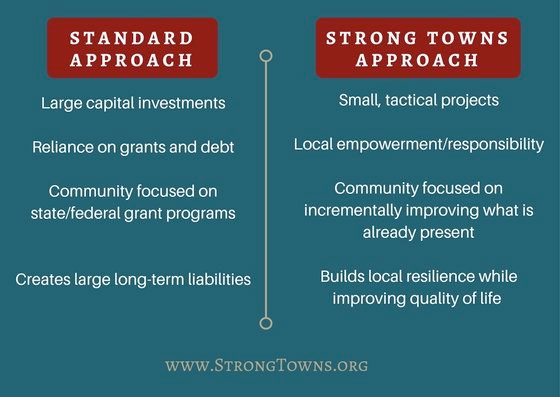This op-ed originally appeared on the StrongTowns.org website on January 3, 2022.
I spent part of my holiday break reading the latest Peter Norton book, Autonorama: The Illusory Promise of High Tech Driving. As expected, it’s an amazing read full of insight; I hope to soon have Norton on the podcast to discuss it.
Perhaps the most clarifying thing in the book for me was how it explained the mass adoption of the automobile and motordom as a lifestyle. The transition wasn’t as easy as one might think looking back on it today. As Norton writes, “The drive-everywhere, drive-only city was never easy to sell—otherwise, the lavish efforts to sell it would have been unnecessary.”
Those lavish efforts were essentially a joint project between the titans of industry (let’s just call them “corporations”) and those who had the ability to change public policy (let’s simplify and call them “government”). Since citizens and consumers have free will, along with the freedom to buy the products they want and vote for the candidates they prefer, the alignment of interests between corporations and government needed, at a minimum, the acquiescence of the American people. Ideally, it would have their wholehearted embrace.
Getting that embrace was really tricky. It required the government to, as Norton says, use public policy and public money to “destroy and rebuild American surface transportation around motor vehicle travel, in ways that deprived travelers of a marketplace of competing modes, with the express intention of promoting demand for motor vehicles.”
At the same time, corporations needed to “propagate the notion that public policy was merely following mass preferences, and that the entire conversion was the consequence of the free market.” In other words, the government was merely doing what the nation’s consumers wanted, the government flipping of the chess board to serve a new corporate vision merely an expression of market preference.
In 2022, it is easy to default to looking at this history through the modern paradigm, with red-oriented regions and politicians arguing—wholly implausibly—that auto-based development patterns are an expression of the free market while blue-oriented regions and politicians join them in embracing the government side of that endeavor. Easy, but such a backward projection would be ahistorical.
In 1940, General Motors produced a video called “To New Horizons” as part of their Futurama exhibit at the World’s Fair. As someone who has studied Jonathan Haidt’s work on moral foundations, it was easy for me to see how the pitch appealed to those of both liberal and conservative disposition.
I’m going to simplify “left” and “right” here, while acknowledging that there is always nuance.
“To New Horizons” suggests that highway construction is creating “new ways of living and new thinking” (left) while also laying “the foundation for most of what is good in life today” (right).
Here is the 23-minute film, as posted on YouTube.
It goes on to say that, because of highways, “distant families have become neighbors” (right) and “people have constantly widened their viewpoints” (left). A narrative crescendo suggests “the highways of social [left] and commercial [right] developments are widening without end or limit.”
An appeal to common unifying narratives is how you move a diverse and complex society of people to action, and that’s what this is. It touches left and right without pushing either away. And it frames all these changes, including higher taxes, more bureaucracy, and a complete dismantling of local economic ecosystems, in terms of things improving for everyone. As propaganda, this is genius.
And it has me thinking about our project, the Strong Towns movement, a push to strengthen our cities, towns, and neighborhoods so people can live a good life in a prosperous place.
We have the negative Strong Towns story in place: Our current development pattern is bankrupting our cities, our families, and our small businesses. It induces them to take on enormous long-term obligations in pursuit of comparatively small short-term gains. In order to foolishly chase the capital that flows top-down through government programs and corporate systems, we sacrifice not only our financial strength, but our quality of life, safety, opportunity, health, resilience, and many other things we locally value more. We need to change.
We even have an approach for how to make that change. A Strong Towns approach means that we:
- Stop valuing efficiency and start valuing resilience.
- Stop betting our futures on huge, irreversible projects, and start taking small, incremental steps and iterating based on what we learn.
- Stop fearing change and start embracing a process of continuous adaptation.
- Stop building our world based on abstract theories, and start building it based on how our places actually work and what our neighbors actually need today.
- Stop obsessing about future growth and start obsessing about our current finances.
- Put faith and power in ourselves and our neighbors to co-create the places we live.
- Many specific policies and programs flow from this way of thinking.
What we have not had is the futurama-like vision and narrative for how the world will be better with a Strong Towns approach. Sure, we talk about safer streets, lower taxes, affordable housing, greater small business opportunities, increased public health, real job creation, a better environment, and many more things. We talk about these things, absolutely, but mostly as abstract outcomes in a broader policy debate, not as real lived experiences that people can have right now.

